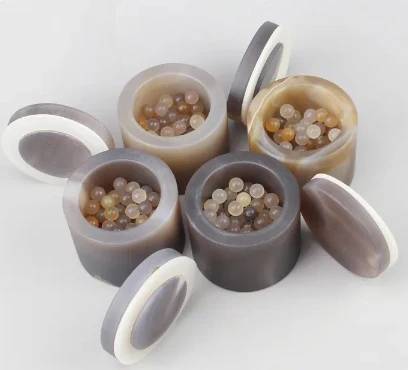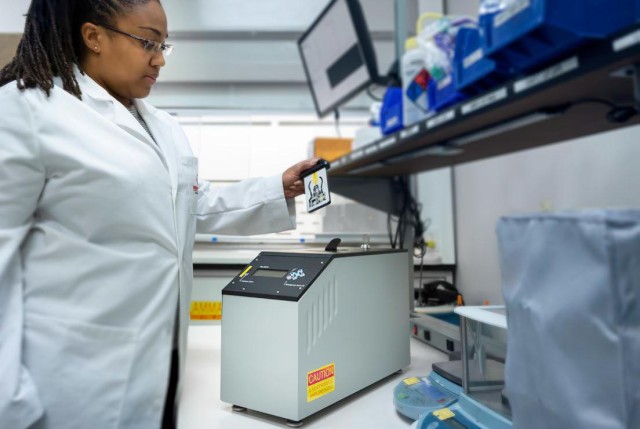Understanding Planetary Ball Mills

Planetary ball mills are a powerful tool for grinding, mixing, homogenizing, and mechanical alloying of diverse materials. These mills feature a unique design, with the grinding jars arranged eccentrically on a so-called sun wheel, generating high dynamic energies through frictional and impact forces.
The rotation directions of the bowl and turn disc are opposite, resulting in synchronized centrifugal forces. As a result, friction is produced from the hardened milling balls and the powder mixture being ground, alternately rolling on the inner wall of the bowl and striking the opposite wall. The impact energy of the milling balls in the normal direction can be up to 40 times higher than that due to gravitational acceleration, enabling high-speed milling.
The ball milling process typically takes approximately 100 to 150 hours to achieve uniform fine powder, with the mechanical energy leading to structural and chemical changes in the material. Notably, this method can produce nano powders ranging from 2 to 20 nm in size, with the size depending on the speed of the rotation of the balls. Moreover, it is a cost-effective and straightforward process that also results in the production of crystal defects.
Planetary ball mills are smaller than common ball mills and are primarily used in laboratories for grinding sample material down to very small sizes. The grinding jars in a planetary ball mill are subjected to superimposed rotational movements, facilitated by the arrangement eccentrically on a sun wheel. These movements lead to an interplay between frictional and impact forces, resulting in the release of high dynamic energies, thus achieving a high and effective degree of size reduction.
In conclusion, planetary ball mills offer a unique and efficient method for high-speed milling, production of nano powders, as well as the synthesis of diverse nanoparticles with various industrial applications.
Advantages over Ordinary Ball Mills
When comparing planetary ball mills with ordinary ball mills, several key advantages become evident. Planetary ball mills are known for their ability to produce ultrafine and nano-sized materials, making them highly suitable for various research and industrial applications. The inexpensive and easy process of ball milling is a distinct advantage, making it accessible for a wide range of users. Furthermore, planetary ball mills excel in the production of crystal defects, which can be crucial for certain material properties. Additionally, the versatility of planetary ball mills enables the grinding of various materials, ranging from soft to extremely hard, brittle, and fibrous materials.
Optimizing Productivity

The productivity of ball mills is influenced by various factors such as drum diameter, length, filling of the mill by balls, armor surface shape, speed of rotation, and milling fineness. Achieving the optimum ratio between length and diameter, along with the timely movement of ground product, is crucial for maximizing efficiency.
By increasing the rotation rate, the centrifugal force and helix angle of the balls in the mill increase as well. This, in turn, affects the milling efficiency. Excessive filling of the mill with balls can lead to collisions between rising and falling balls, impacting the overall productivity and efficiency. It is generally advised that the mill should not be filled by balls exceeding 30–35% of its volume to ensure optimal performance.
The degree of milling in a ball mill is influenced by factors such as the material to be ground, the speed of rotation, the size and type of grinding medium, and the filling ratio of the mill. Additionally, the productivity of ball mills depends on the drum diameter and the ratio between length and diameter (L:D). The accepted optimum ratio falls within the range of 1.56–1.64.
Physical-chemical properties of the feed material, armor surface shape, speed of rotation, milling fineness, and timely movement of ground product are other crucial factors impacting the productivity of ball mills. It's important to note that ball mills exhibit high specific energy consumption, consuming almost as much energy at idle as they do at full-scale capacity. Therefore, operating a ball mill at less than full capacity is highly disadvantageous in terms of energy consumption.
The aim of achieving ultrafine and nano-sized materials for innovative product development has driven the use of high-energy ball mills. These mills play a critical role in grinding applications, breaking down coarse feed materials and forming fine products. Achieving effective grinding in a ball mill requires operating above the critical speed to ensure continuous tumbling and impacting of the material to be ground.
In summary, optimizing the productivity of ball mills involves careful consideration of various factors, including drum dimensions, filling ratios, rotation speed, and the timely removal of ground product. These considerations are essential for achieving efficient and effective milling processes.
Managing Specific Energy Consumption

Ball mills are widely utilized for grinding hard and brittle materials with high kinetic energy, producing ultra-fine particles in a short time span. The high specific energy consumption of ball mills can be a significant challenge, particularly when operated at less than full capacity. This section will delve into the disadvantages of using ball mills at less than full capacity, the factors contributing to high energy consumption, and the implications of working idle.
One of the major disadvantages of using a ball mill at less than full capacity is the high specific energy consumption. When a mill is filled with balls and working idle, it consumes approximately as much energy as it does during the grinding of material at full-scale capacity. This presents a considerable drawback in terms of energy efficiency and cost-effectiveness.
The specific energy consumption of ball mills is influenced by several factors, including the physical-chemical properties of the feed material, the filling of the mill by balls and their sizes, the shape of the armor surface, the speed of rotation, milling fineness, and the timely removal of ground product. It is important to consider these factors in order to optimize energy utilization and enhance the overall productivity of the milling process.
Furthermore, the high energy consumption during the grinding process in ball mills can lead to increased wear of the equipment. The friction between the material and the grinding medium results in serious wear of parts, necessitating timely replacement and maintenance. Additionally, the substantial energy requirements of ball mills demand careful attention to controlling energy consumption during equipment operation to mitigate operational costs.
In addition to these challenges, the operation of ball mills at less than full capacity can contribute to noise pollution due to the equipment's high-speed rotation, leading to loud noise production. This not only poses environmental concerns but also impacts the working conditions and overall operational environment of the facility.
In conclusion, the management of specific energy consumption in ball mills is crucial for enhancing energy efficiency, reducing operational costs, and maintaining product quality. Addressing the factors that contribute to high energy consumption and understanding the implications of working idle are vital steps towards optimizing the performance of ball mills in industrial and laboratory settings.
Innovative Applications of Planetary Ball Mills
High-energy ball mills are the key to achieving ultrafine and nano-sized materials for innovative product development. These mills use balls or beads to crush, grind, or impact materials with high kinetic energy, resulting in rapid and efficient size reduction. They are commonly used for grinding hard and brittle materials, such as metals, alloys, ceramics, and minerals, as well as for mechanical alloying, mixing, and homogenization of various materials.
High-energy ball milling is the only top-down approach for nanoparticle synthesis and is known for its speed, intensity, and ability to produce ultra-fine particles in a short amount of time. Despite some common drawbacks, such as low surface area and partially amorphous states of the prepared powders, high-energy ball milling has been used for the generation of magnetic, catalytic, and structural nanoparticles. With the use of tungsten carbide components and inert atmosphere or high vacuum processes, contamination problems from ball-milling processes have been greatly reduced, making it suitable for many industrial applications.
Planetary ball mills are high-performance all-rounders in routine laboratory work, allowing for the synthesis of ultrafine and nano-sized materials. These mills are designed with vertically oriented equipment containing rotary cutters to achieve the desired particle sizes. The diverse components and functionalities of planetary ball mills make them essential for achieving the innovative applications required in various fields.
In conclusion, by utilizing high-energy ball milling and planetary ball mills, researchers can achieve the synthesis of ultrafine and nano-sized materials, leading to the development of innovative products across different industries.
Related Products
- High Energy Planetary Ball Mill Milling Machine for Laboratory
- Laboratory Planetary Ball Mill Cabinet Planetary Ball Milling Machine
- Laboratory Planetary Ball Mill Rotating Ball Milling Machine
- High-Energy Omnidirectional Planetary Ball Mill Machine for Laboratory
- High-Energy Omnidirectional Planetary Ball Mill Milling Machine for Laboratory
Related Articles
- Advantages of Planetary Ball Mill in Laboratory Applications
- Choosing the Best Material for Ball Mill: Essential Factors and Recommendations
- Features of Different Laboratory Mills: An Overview
- Disc / Cup Vibratory Mill: A Comprehensive Guide to Its Functions and Applications
- The Three Stages of Lab Crushing: A Comprehensive Guide















